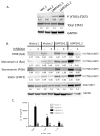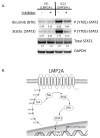Epstein-Barr Virus Latent Membrane Protein 2A (LMP2A) enhances IL-10 production through the activation of Bruton's tyrosine kinase and STAT3
- PMID: 27792904
- PMCID: PMC5127766
- DOI: 10.1016/j.virol.2016.10.015
Epstein-Barr Virus Latent Membrane Protein 2A (LMP2A) enhances IL-10 production through the activation of Bruton's tyrosine kinase and STAT3
Abstract
Previous data demonstrate that Epstein-Barr Virus Latent Membrane Protein 2A (LMP2A) enhances IL-10 to promote the survival of LMP2A-expressing B cell lymphomas. Since STAT3 is an important regulator of IL-10 production, we hypothesized that LMP2A activates a signal transduction cascade that increases STAT3 phosphorylation to enhance IL-10. Using LMP2A-negative and -positive B cell lines, the data indicate that LMP2A requires the early signaling molecules of the Syk/RAS/PI3K pathway to increase IL-10. Additional studies indicate that the PI3K-regulated kinase, BTK, is responsible for phosphorylating STAT3, which ultimately mediates the LMP2A-dependent increase in IL-10. These data are the first to show that LMP2A signaling results in STAT3 phosphorylation in B cells through a PI3K/BTK-dependent pathway. With the use of BTK and STAT3 inhibitors to treat B cell lymphomas in clinical trials, these findings highlight the possibility of using new pharmaceutical approaches to treat EBV-associated lymphomas that express LMP2A.
Keywords: B cell; Bruton's tyrosine kinase (BTK); Epstein-Barr virus; Interleukin-10; Latent Membrane Protein 2A; Signal Transducer and Activator of Transcription 3 (STAT3).
Copyright © 2016 Elsevier Inc. All rights reserved.
Figures




Similar articles
-
Epstein-Barr virus latent membrane protein 2A (LMP2A) employs the SLP-65 signaling module.J Exp Med. 2001 Aug 6;194(3):255-64. doi: 10.1084/jem.194.3.255. J Exp Med. 2001. PMID: 11489945 Free PMC article.
-
Inhibition of host kinase activity altered by the LMP2A signalosome-a therapeutic target for Epstein-Barr virus latency and associated disease.Antiviral Res. 2002 Dec;56(3):219-31. doi: 10.1016/s0166-3542(02)00110-9. Antiviral Res. 2002. PMID: 12406506
-
LMP2A survival and developmental signals are transmitted through Btk-dependent and Btk-independent pathways.Virology. 2001 Dec 5;291(1):46-54. doi: 10.1006/viro.2001.1187. Virology. 2001. PMID: 11878875
-
Latent Membrane Protein 2 (LMP2).Curr Top Microbiol Immunol. 2015;391:151-80. doi: 10.1007/978-3-319-22834-1_5. Curr Top Microbiol Immunol. 2015. PMID: 26428374 Review.
-
The LMP2A signalosome--a therapeutic target for Epstein-Barr virus latency and associated disease.Front Biosci. 2002 Feb 1;7:d414-26. doi: 10.2741/portis. Front Biosci. 2002. PMID: 11815296 Review.
Cited by
-
Immunosuppressive Tumor Microenvironment and Immunotherapy of Epstein-Barr Virus-Associated Malignancies.Viruses. 2022 May 10;14(5):1017. doi: 10.3390/v14051017. Viruses. 2022. PMID: 35632758 Free PMC article. Review.
-
Dasatinib exacerbates splenomegaly of mice inoculated with Epstein-Barr virus-infected lymphoblastoid cell lines.Sci Rep. 2020 Mar 9;10(1):4355. doi: 10.1038/s41598-020-61300-y. Sci Rep. 2020. PMID: 32152351 Free PMC article.
-
Effects of BTK signalling in pathogenic microorganism infections.J Cell Mol Med. 2019 Oct;23(10):6522-6529. doi: 10.1111/jcmm.14548. Epub 2019 Aug 8. J Cell Mol Med. 2019. PMID: 31397086 Free PMC article. Review.
-
The Microenvironment in Epstein-Barr Virus-Associated Malignancies.Pathogens. 2018 Apr 13;7(2):40. doi: 10.3390/pathogens7020040. Pathogens. 2018. PMID: 29652813 Free PMC article. Review.
-
TIM-3 increases the abundance of type-2 dendritic cells during Leishmania donovani infection by enhancing IL-10 production via STAT3.Cell Death Dis. 2023 May 18;14(5):331. doi: 10.1038/s41419-023-05848-3. Cell Death Dis. 2023. PMID: 37202419 Free PMC article.
References
-
- Ascherio A, Munger KL. EBV and Autoimmunity. Curr Top Microbiol Immunol. 2015;390(Pt 1):365–85. - PubMed
-
- Avni D, Glucksam Y, Zor T. The phosphatidylinositol 3-kinase (PI3K) inhibitor LY294002 modulates cytokine expression in macrophages via p50 nuclear factor kappaB inhibition, in a PI3K-independent mechanism. Biochem Pharmacol. 2012;83(1):106–14. - PubMed
-
- Babcock GJ, Decker LL, Volk M, Thorley-Lawson DA. EBV persistence in memory B cells in vivo. Immunity. 1998;9(3):395–404. - PubMed
-
- Babcock GJ, Hochberg D, Thorley-Lawson AD. The expression pattern of Epstein-Barr virus latent genes in vivo is dependent upon the differentiation stage of the infected B cell. Immunity. 2000;13(4):497–506. - PubMed
-
- Babcock GJ, Miyashita-Lin EM, Thorley-Lawson DA. Detection of EBV infection at the single-cell level. Precise quantitation of virus-infected cells in vivo. Methods Mol Biol. 2001;174:103–10. - PubMed
MeSH terms
Substances
Grants and funding
LinkOut - more resources
Full Text Sources
Other Literature Sources
Miscellaneous

